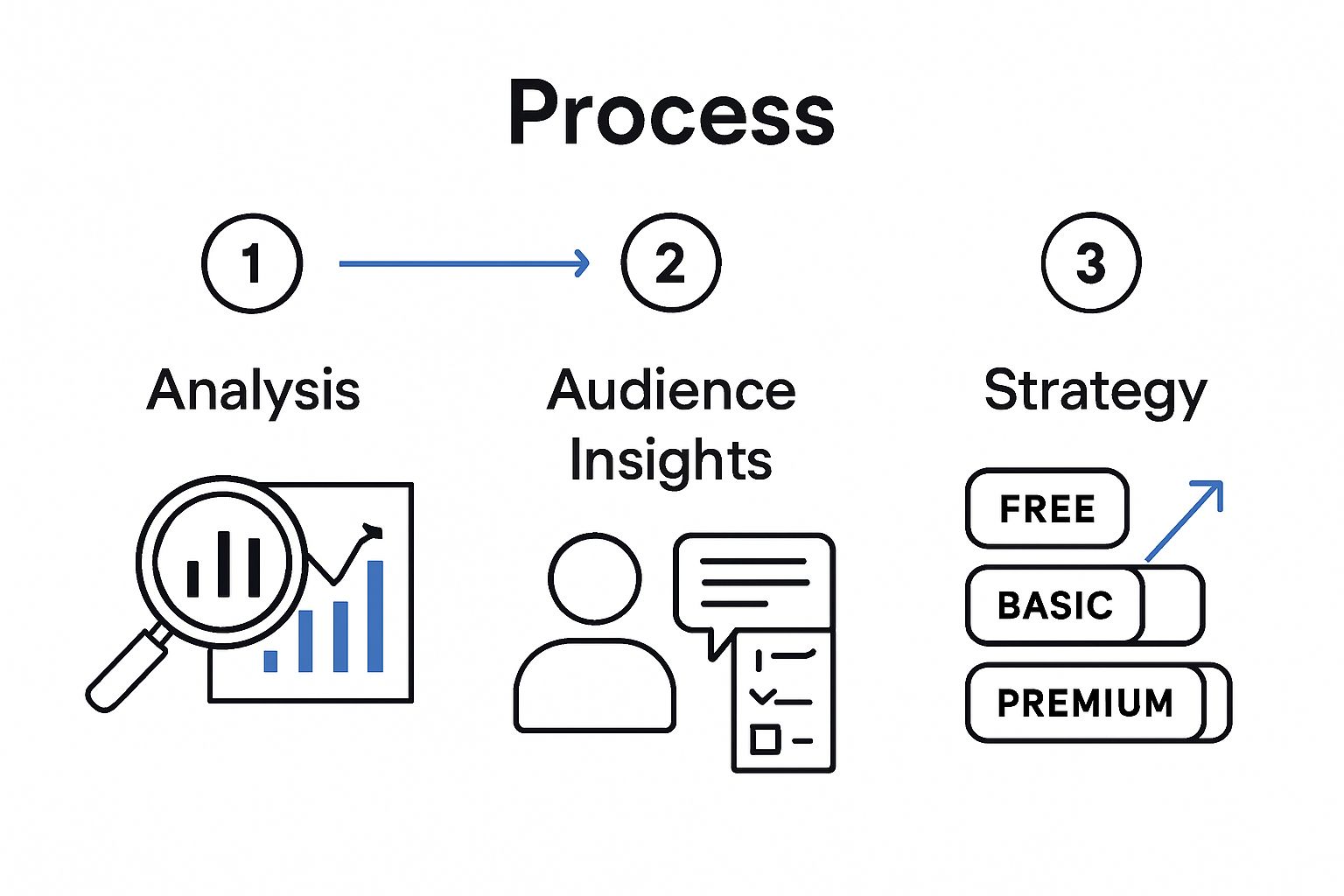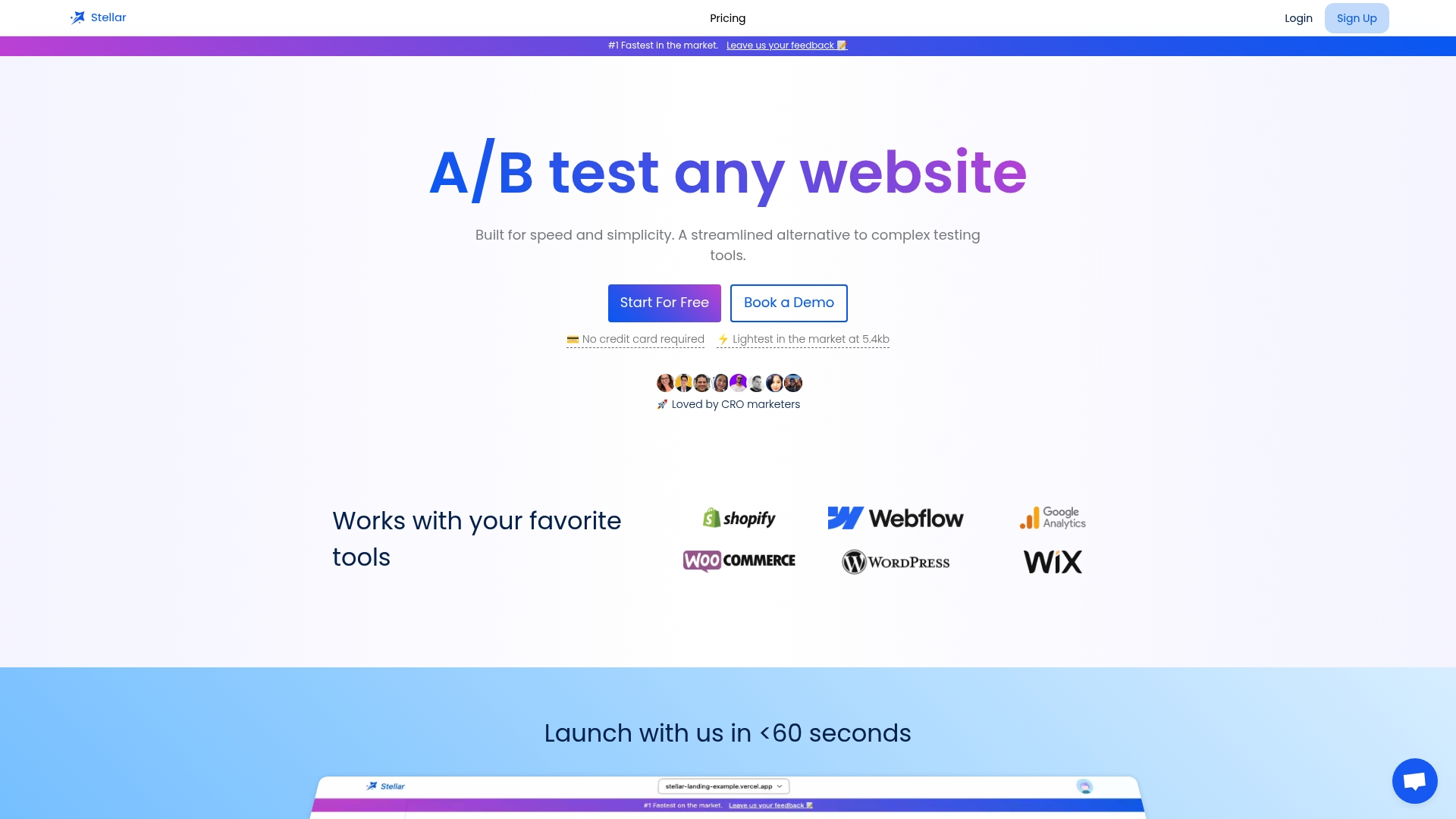
Optimizing Pricing Pages for Maximum Conversions

A well-designed pricing page can make or break a sale. Here is something most businesses miss. Surveys show nearly 60 percent of users abandon their purchase if the pricing page feels confusing or untrustworthy. Yet most companies pour endless energy into product features and marketing, barely glancing at how their pricing pages actually work. The secret to real growth? It starts by treating your pricing page like the highest-stakes sales pitch you have.
Table of Contents
- Step 1: Analyze Current Pricing Page Performance
- Step 2: Identify Target Audience And Their Needs
- Step 3: Develop And Implement Pricing Strategies
- Step 4: Design And Layout For Clarity And Engagement
- Step 5: Test And Refine Pricing Page Elements
- Step 6: Monitor Performance And Iterate Improvements
Quick Summary
| Key Point | Explanation |
|---|---|
| 1. Analyze current pricing performance systematically | Use analytics tools to gather data on user behavior and conversion rates for informed insights. |
| 2. Define your target audience accurately | Create detailed customer personas based on psychographics, needs, and behaviors to tailor your pricing. |
| 3. Develop clear and compelling pricing tiers | Structure pricing plans that solve specific problems for different segments, maintaining transparency and value. |
| 4. Implement intuitive design for user engagement | Utilize visual hierarchy and responsive layouts to simplify decision-making and guide users effectively. |
| 5. Continuously test and refine elements | Regular A/B testing and monitoring are essential for adapting your pricing to evolving user preferences and market dynamics. |
Step 1: Analyze current pricing page performance
Optimizing pricing pages begins with a comprehensive performance analysis. Your goal is to uncover actionable insights that reveal how potential customers interact with your current pricing structure. Start by gathering quantitative and qualitative data from multiple sources to build a comprehensive understanding of your page's effectiveness.
Utilize web analytics tools like Google Analytics to track critical metrics such as page views, time on page, bounce rate, and conversion rate. These numbers provide an objective snapshot of your pricing page's current performance. Pay special attention to conversion funnel dropout points where potential customers exit before completing a purchase. These moments represent critical friction points that demand immediate investigation.
Complement quantitative data with qualitative insights through user feedback and behavior tracking. Tools like Hotjar offer heatmaps and session recordings that reveal exactly how users navigate your pricing page. Watch for patterns such as:
- Sections where users pause or scroll erratically
- Elements that receive minimal interaction
- Points where users hesitate before abandoning the page
Beyond technical analysis, conduct direct user interviews or surveys to understand psychological barriers preventing conversions. Ask open-ended questions about pricing perceptions, feature value, and decision-making processes. This human-centered approach provides nuanced insights that raw data might miss. Learn more about testing pricing strategies to refine your approach.
Successful analysis means developing a holistic view of your pricing page's performance. Document your findings systematically, creating a baseline measurement that will help you track improvements in subsequent optimization efforts.
Below is an overview table summarizing each key step for optimizing your pricing page, along with the main action focus and expected outcome.
| Step | Main Focus | Expected Outcome |
|---|---|---|
| 1. Analyze Current Performance | Collect quantitative and qualitative data | Identify friction points, establish optimization baseline |
| 2. Identify Target Audience | Develop customer personas and segment audience | Create tailored pricing that resonates with each segment |
| 3. Develop Pricing Strategies | Structure differentiated pricing tiers and use value-based tactics | Offer clear choices and maximize perceived value |
| 4. Design for Clarity | Implement clear visual hierarchy and responsive design | Guide users intuitively, reduce cognitive friction |
| 5. Test & Refine | Run A/B tests and track user interactions | Evidence-based improvements that increase conversions |
| 6. Monitor & Iterate | Ongoing performance tracking and data review | Maintain pricing relevance and achieve sustained conversion gains |
 Remember, the most effective pricing pages are those continuously refined through data-driven insights and user-centric design.
Remember, the most effective pricing pages are those continuously refined through data-driven insights and user-centric design.
Step 2: Identify target audience and their needs
Target audience identification transforms pricing page optimization from guesswork to strategic precision. Understanding who will actually purchase your product is the critical foundation for creating compelling pricing structures that resonate deeply with potential customers.
Begin by developing comprehensive customer personas that go beyond basic demographics. Dive into psychographic details including pain points, professional challenges, budget constraints, and decision-making motivations. Use customer interviews, sales team insights, and existing client data to construct nuanced profiles. Segment your audience based on behavioral patterns rather than surface-level characteristics. This means categorizing potential customers by their technological literacy, purchasing power, and specific problem-solving needs.
Conducting qualitative research becomes paramount in this phase. Schedule direct conversations with existing customers and prospects to uncover their perceived value propositions. Ask probing questions about what pricing factors matter most to them. Some organizations discover that flexibility matters more than absolute price point, while others find that transparent feature breakdowns drive conversions.
Utilize tools like customer survey platforms and Typeform to gather structured feedback. Create surveys that reveal not just surface preferences but underlying motivations. Quantitative data combined with narrative insights provides a holistic view of your potential customers' decision-making landscape. Learn more about increasing conversions through strategic approaches to refine your understanding.
Verify your audience research by cross-referencing multiple data sources. Successful audience identification means you can anticipate customer objections, articulate value propositions precisely, and design pricing tiers that feel personally tailored. The goal is transforming your pricing page from a generic transaction point into a compelling, individualized conversation that speaks directly to each customer segment's unique requirements.
Step 3: Develop and implement pricing strategies
Developing effective pricing strategies transforms your pricing page from a static transaction point into a dynamic conversion engine. The core objective is creating pricing tiers that feel personalized and compelling to each identified customer segment while maintaining clear value communication.
Start by designing pricing structures that reflect your audience's diverse needs and financial capabilities. Implement a tiered approach that provides clear differentiation between plans. Craft each tier as a strategic solution, not just a price point. This means developing packages that solve specific problems for different customer segments. For instance, create an entry-level plan for small businesses, a professional tier for growing teams, and an enterprise solution for larger organizations.
Transparency becomes crucial in your pricing strategy. Break down exactly what features are included in each tier, using clear language that highlights tangible benefits. Avoid technical jargon or complex pricing structures that might confuse potential customers. Visual hierarchy matters tremendously - use design elements that guide users naturally toward the most appropriate pricing tier for their needs.
Incorporate psychological pricing techniques strategically. Offer a recommended or most popular plan that subtly guides users toward your preferred option. Use comparative pricing that makes your desired tier look like the most attractive choice. Consider implementing value-based pricing that emphasizes the return on investment rather than just the cost. Research on pricing strategies suggests that perceived value trumps absolute price in many purchasing decisions.
Leverage social proof and trust signals within your pricing page design. Include customer testimonials, case studies, and trust badges near pricing tiers. Explore our comprehensive guide on conversion optimization to understand how trust elements can significantly impact purchasing decisions. Verification of a successful pricing strategy comes through increased conversion rates, reduced customer acquisition costs, and positive user feedback.
Here is a comparison table outlining essential tools and resources for each major phase of pricing page optimization, showing their primary purpose and what insights they provide.
| Tool/Resource | Purpose | Insights Provided |
|---|---|---|
| Google Analytics | Track user behavior and conversion data | Key metrics like page views, bounce, and conversion rates |
| Hotjar | Gather heatmaps and session recordings | Visualize user interactions and hesitation points |
| Customer Surveys (SurveyMonkey, Typeform) | Collect structured user feedback | Uncover preferences, motivations, objections |
| A/B Testing Platforms | Experiment with design and messaging | Determine impact of specific page changes |
| Analytics Dashboards | Monitor overall performance over time | Evaluate trends in user engagement and ROI |
| Cohort Analysis Tools | Segment users for trend discovery | Identify group-specific responses post-pricing changes |
Step 4: Design and layout for clarity and engagement
Designing a pricing page that converts requires a strategic approach to visual communication and user experience. The layout must guide users intuitively through their decision-making process, transforming complex pricing information into a clear, compelling narrative that reduces cognitive friction.
Start by creating a visual hierarchy that naturally draws the eye to the most important information. Use clean, minimalist design principles that eliminate unnecessary visual clutter. Typography and color play crucial roles in guiding user attention. Select a font that maintains readability across different devices, with clear size differentiation between headings, subheadings, and body text. Choose a color palette that highlights key action points without overwhelming the user.
Implement responsive design principles that ensure your pricing page looks equally compelling on desktop, tablet, and mobile devices. This means creating flexible layouts that adapt seamlessly to different screen sizes while maintaining clarity and readability. Pay special attention to how pricing tiers stack and how comparison elements display on smaller screens. Explore our insights on designing effective landing pages to refine your approach to visual communication.
Create visual comparison tools that make decision-making effortless. Use clean, easy-to-read comparison tables that highlight the unique value of each pricing tier. Incorporate visual cues like checkmarks, icons, and subtle background colors to differentiate features. Implement clear call-to-action buttons that stand out with contrasting colors and compelling microcopy. Ensure each button communicates the specific value users will receive by clicking.
Verification of an effective design comes through user testing and conversion rate analysis. Conduct A/B testing to compare different layout variations, tracking how small design changes impact user engagement and conversion rates. Research on landing page optimization suggests that even minor design adjustments can significantly influence user behavior. The ultimate goal is creating a pricing page that feels intuitive, trustworthy, and aligned with your brand's unique value proposition.

Step 5: Test and refine pricing page elements
Testing and refining your pricing page transforms theoretical strategies into data-driven optimization. Systematic experimentation becomes the key to unlocking higher conversion rates by revealing exactly what resonates with your target audience. This step moves beyond intuition, using concrete evidence to guide your design and messaging decisions.
Implement A/B testing as your primary method of validation. Create multiple variations of your pricing page that test specific elements like headline wording, feature descriptions, button colors, and pricing tier arrangements. Use robust testing platforms that provide statistically significant results. Focus on testing one element at a time to isolate the precise impact of each change.
This approach prevents muddying your experimental results and provides clear insights into what drives user behavior.
Utilize advanced tracking tools that capture granular user interaction data. Heat mapping software and session recordings help you understand how users navigate your pricing page, where they pause, and what elements capture their attention. Learn more about A/B testing strategies to refine your approach to conversion optimization. Pay special attention to micro-interactions like cursor movements, scroll depth, and time spent on different sections.
Research on continuous testing indicates that pricing page optimization is an ongoing process. Establish a regular testing cadence, perhaps running experiments quarterly or after significant product updates. Develop a systematic framework for collecting, analyzing, and implementing test results. Create a testing roadmap that prioritizes experiments based on potential impact and ease of implementation. Track key metrics including conversion rate, average revenue per user, and customer acquisition cost to measure the tangible business impact of your refinements. The most successful pricing pages are not static documents but living, evolving assets that continuously adapt to user preferences and market dynamics.
Step 6: Monitor performance and iterate improvements
Monitoring and iterating your pricing page represents the critical final phase of optimization, transforming initial improvements into sustained conversion success. Continuous performance tracking becomes your strategic compass, guiding future refinements and ensuring your pricing strategy remains dynamically aligned with market demands.
Establish a comprehensive analytics dashboard that tracks key performance indicators beyond basic conversion rates. Monitor metrics such as average revenue per user, customer lifetime value, churn rate, and segment-specific conversion percentages. These nuanced measurements provide deeper insights into how different customer segments interact with your pricing structure. Implement cohort analysis to understand how various user groups respond to pricing changes over time, revealing long-term trends that single-snapshot metrics might obscure.
Explore advanced landing page performance strategies to enhance your monitoring approach. Integrate multiple data sources, including web analytics, user feedback platforms, and customer support interactions. This holistic approach ensures you're capturing both quantitative and qualitative insights about your pricing page's effectiveness. Pay special attention to friction points where potential customers abandon the purchasing process.
Research on continuous optimization suggests establishing a regular review cadence. Schedule monthly or quarterly deep-dive sessions to analyze performance data, review experimental results, and prioritize potential improvements. Create a systematic framework for translating insights into actionable updates. This might involve adjusting pricing tiers, refining feature descriptions, or redesigning visual elements based on empirical evidence. The most successful pricing pages are living documents that evolve continuously, responding to changing market dynamics and user preferences. Verification of effective monitoring comes through sustained improvements in conversion rates, increased average revenue per user, and positive customer feedback across different segments.
Unlock Conversion Insights With Stellar’s Seamless A/B Testing
Tired of guessing what hurts your pricing page conversions? This article highlighted how unclear layouts, confusing pricing tiers, and data blind spots drive visitors away before they act. You read about the importance of ongoing A/B tests, visual clarity, and real-time analytics to truly maximize each visit.

Take control today with Stellar’s SaaS solution, crafted to remove friction from your optimization workflow. With Stellar you skip code headaches and launch lightning-fast tests in minutes. See live user responses to your new pricing structures, compare multiple page designs, and make confident decisions using our no-code visual editor and goal tracking tools. Want to see what effortless A/B testing feels like? Visit Stellar’s homepage now and find a pricing plan tailored for your team. See why growing businesses trust Stellar to boost conversions without slowing their sites. Try it for free and turn insights into results before your next competitor does.
Frequently Asked Questions
How can I analyze the performance of my pricing page?
Start by using web analytics tools to track key metrics like page views, bounce rate, and conversion rate. Analyze this data to pinpoint where potential customers drop off and identify areas for improvement.
What steps should I take to identify my target audience for pricing page optimization?
Develop customer personas that include details like pain points and budget constraints. Conduct interviews or surveys to gather insights that help you understand what pricing features resonate with your audience.
How do I create pricing tiers that appeal to different customer segments?
Design pricing tiers based on the unique needs of your audience, ensuring each tier addresses specific problems they face. Use clear language to communicate the benefits of each tier, making it easy for potential customers to choose a plan that fits their requirements.
What are some effective design practices for a conversion-focused pricing page?
Utilize clean, minimalist design with a clear visual hierarchy to guide user decision-making. Implement comparison tables and distinct call-to-action buttons to help users easily understand their options and encourage conversions.
How often should I test and refine elements on my pricing page?
Establish a regular testing schedule, such as running A/B tests quarterly or after any significant product changes. This process will ensure that your pricing page is continuously optimized and aligned with user preferences.
What metrics should I monitor to evaluate the success of my pricing page?
Track metrics such as conversion rates, churn rate, and average revenue per user to assess overall performance. Implement cohort analysis to observe how different customer segments respond to your pricing strategies over time.
Recommended
Published: 10/14/2025